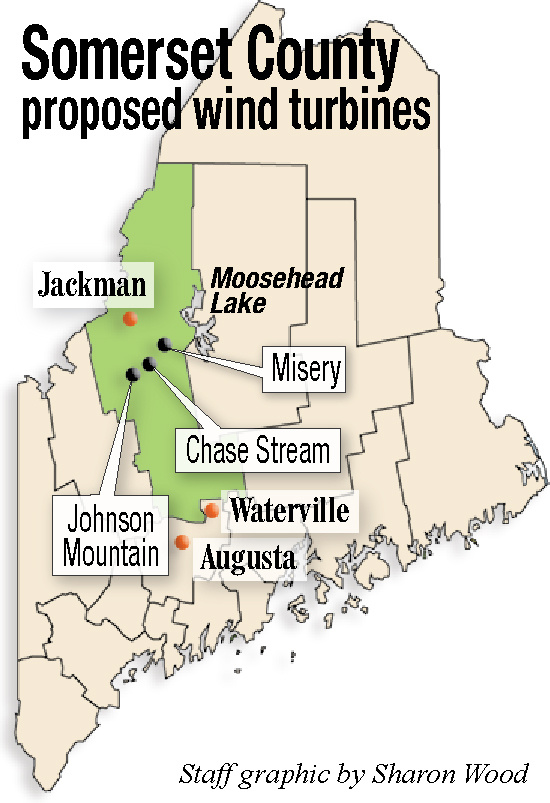SKOWHEGAN — Early plans for more than 200 new wind turbines in rural Somerset County are drawing criticism from a group that fears industrial wind development will hurt the economy and quality of life for area residents.
Richard McDonald, president of the anti-wind citizen group Saving Maine, is set to deliver a 30-minute presentation on the group’s opposition to the wind power projects to Somerset County commissioners starting at 3 p.m. Wednesday in Rockwood Strip. McDonald, who says he will also speak on behalf of the group Moosehead Region Futures, said that while permits for new wind projects have yet to be filed, the prospect is not welcome of 100-foot tall turbines along ridges in the remote townships of Johnson Mountain, Chase Stream and Misery, just west of Moosehead Lake.
“We currently have a mix of things going on,” McDonald said by phone Monday morning.
He said the Somerset Wind project has been proposed by NRG, a large renewable energy and power producer with offices in Texas and New Jersey. There also is what is being called the EverPower Project, along Big Moose Mountain ridge line near Big Indian Pond, he said. Each would have 26 or 28 wind turbines, generating at 100 percent capacity between 78 and 93 megawatts of power.
He said a company called NextEra also has proposed two or three large industrial wind projects in the Eustis area of Franklin County.
All together, wind projects could result in 204 new wind turbines generating 703 megawatts of power.
David Gaier, the NRG East Region senior director and spokesman in New Jersey, said Monday that the Somerset Wind project is still in its infancy.
“Last year NRG acquired the rights to build the Somerset Wind project, but at this point we’re only in the early project development stage,” Gaier said in an email Monday afternoon. “We’re looking forward to continuing the development process in the coming months and we’ll make more information available when appropriate.”
John Carroll, a spokesman for Central Maine Power Co., said Monday that he is familiar with the Somerset Wind project proposed by NRG. He said CMP put in bids for the “green power” corridor connection from northern Franklin County and Quebec, through Somerset County to Massachusetts.
“We put in two proposals to deliver clean energy to Massachusetts,” Carroll said by phone Monday. “Somerset Wind put in a proposal saying that they would connect to our substation — they’re not in our proposal, but there would be capacity in our substation, so they put in a proposal that said they would connect there if that project is selected. NRG is the company behind it.”
CMP would operate the transmission lines, which would cross Somerset County, he said. The substation would only be built if the company is selected to be part of the Massachusetts request for green energy supply, Carroll said.
“This is all being driven by a large renewable energy proposal for a request for proposal from the Massachusetts Department of Energy for 9.5 million megawatt hours,” McDonald said. “They put the bid out to all producers of renewables in New England and in Canada.”
The driving force, he said, is to win the bid for a 20-year power purchase agreement with the state of Massachusetts utilities for more than 100 wind turbines. The projects were among the 24 bids received by New England Clean Energy RFP, part of a group of agencies and electric utilities in Connecticut, Massachusetts and Rhode Island that issued a request for proposals for energy projects last November to help them meet their clean-energy goals and fight climate change.
Another important part of the plan, McDonald said, would be a 145-mile transmission line by CMP to get the power to Massachusetts from west of Eustis to Johnson Mountain, The Forks, West Forks — right over the Dead River — then down to Moscow, Pittsfield and finally to southern Maine. He said it would be 1,400 feet wide.
A coalition of utilities and state agencies in southern New England failed to select any Maine-based wind or transmission projects to meet the region’s clean-energy goals last December, but projects that didn’t win already were looking ahead to a second chance, and an even bigger RFP process, the Portland Press Herald reported.
McDonald said his group points to a recent study by the John Muir Society that says the installation of industrial wind power and transmission corridors in Scotland would diminish tourist visits by 55 percent.
“Moosehead Region Futures has been doing this for two years and we’ve been very vocal about our concerns — our stand is that we want to defeat these projects,” McDonald said. “You have to think about real estate; you got to think about the impact this could have on property values. Going to these areas such as Moosehead and seeing an industrialization on the scale that they’re talking about with these projects and the transmission corridor, I can see the Moosehead region taking a very heavy hit.”
Somerset County Administrator Dawn DiBlasi said Monday that county commissioners do not have a vote on placement of new wind farms, but can give a thumbs up or thumbs down consensus. She said McDonald and his group are opposed to the wind towers and commissioners know that.
DiBlasi said McDonald came to a meeting earlier this year with a slide show presentation about wind turbines.
“He feels it would be a real problem for people who vacation up there; people who go up there on purpose to get away from cities and towns and industrialization,” DiBlasi said Monday. “There’s been talk about wind towers going over Coburn Mountain and within eyesight of Moosehead. That spurred on the opposition — they’re trying to make that point, that it would devastate tourism up there if the wind towers came.
“Right now it’s all just talk, nobody has actually come out and said they were putting wind towers there,” she said. “Bingham has wind towers, Mayfield has wind towers.”
Construction of the $420 million 56-turbine Bingham wind farm started in July 2015. The project generates about 185 megawatts of electricity, enough to power the equivalent of 60,000 homes. The turbines are spread across high ridges in Bingham, Mayfield Township and Kingsbury Plantation and 120 people worked on the project, both at the site and away from the site.
Opponents of the Bingham project have said wind farms detract from the scenery in rural Maine. DEP regulations state that scenic impact is only a consideration in evaluating a wind project if turbines fall within 8 miles of the area of concern.
DiBlasi asked a question Monday that many have asked since the Bingham wind project went on line: “Would it get us power cheaper if power was being supplied to Massachusetts? Would the cost of power to us in Maine go down? That the hope.”
Doug Harlow — 612-2367
Twitter:@Doug_Harlow
Send questions/comments to the editors.





Comments are no longer available on this story